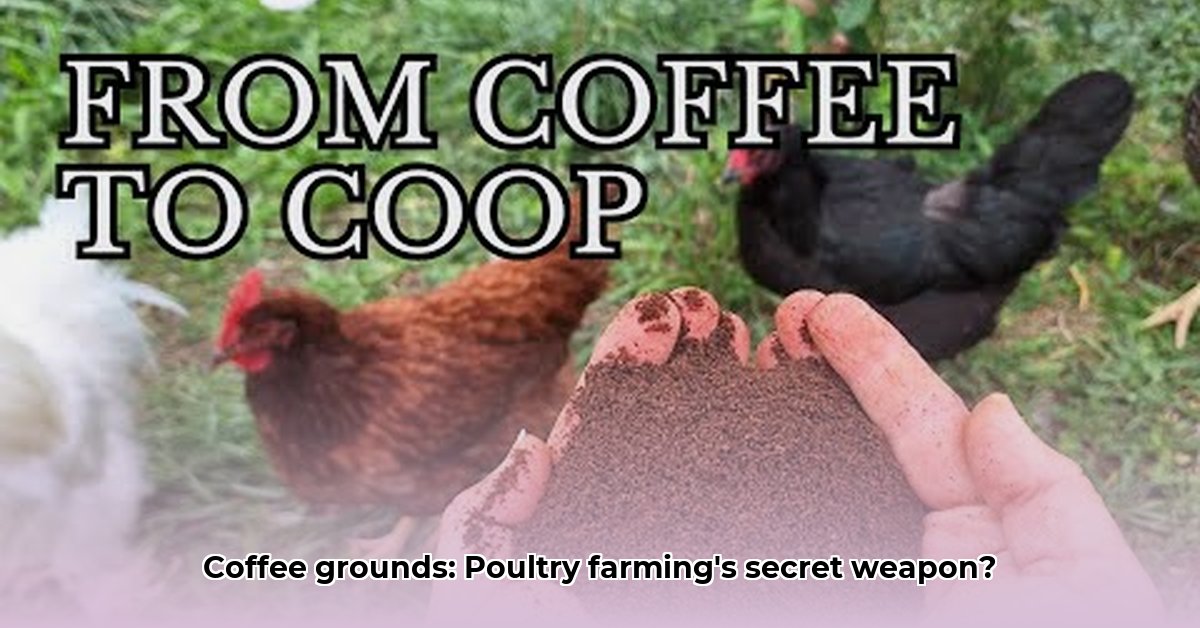
Let's revolutionize poultry farming with a sustainable and surprisingly effective bedding solution: coffee grounds! This comprehensive guide will walk you through the benefits, sourcing, preparation, and maintenance of coffee ground bedding, transforming your coop into a greener, healthier haven for your chickens. For more options, check out other bedding options.
The Amazing Perks of Coffee Ground Bedding
Tired of the pungent ammonia smell and the high cost of traditional poultry bedding? Coffee grounds offer a natural, cost-effective, and eco-friendly alternative. Did you know that coffee grounds are incredibly absorbent, reducing ammonia odors by up to 70%? [1] This dramatically improves air quality in your coop, benefiting both your chickens' respiratory health and your sense of smell.
Beyond odor control, coffee grounds act as a natural pest deterrent, helping to keep unwanted insects and mites at bay. This reduces the need for potentially harmful pesticides, promoting a healthier environment for your flock. Plus, coffee grounds are completely compostable, enriching your garden soil after their time in the coop.
Sourcing Your Coffee Ground Bedding: Two Great Paths
You have two primary options for obtaining coffee grounds: commercial suppliers and local coffee shops.
Option 1: Commercial Suppliers – The Convenience Route
Purchasing pre-dried coffee grounds specifically formulated for animal bedding from farm supply stores offers convenience and consistency. However, this option is typically more expensive than sourcing locally.
Option 2: Local Coffee Shops – The Budget-Friendly and Community-Minded Approach
Partnering with local coffee shops offers a cost-effective and sustainable solution. Collecting their spent grounds directly reduces their waste and provides you with a plentiful supply of bedding material. However, this requires more effort in terms of collection, drying, and potential inconsistencies in grind size.
Tips for Local Sourcing:
- Personal Approach: Introduce yourself and explain your project, emphasizing the environmental benefits.
- Negotiate a Schedule: Establish a regular collection schedule that works for both you and the coffee shop.
- Volume Assessment: Inquire about their daily coffee volume to estimate your needs and ensure consistent pickup.
Preparing and Using Your Coffee Ground Bedding: A Step-by-Step Guide
Step 1: Drying the Grounds: Thoroughly dry fresh coffee grounds to prevent mold and mildew. Sun-drying is the simplest method, but a dehydrator or low-heat oven (around 170°F) can accelerate the process. Ensure even drying by stirring periodically.
Step 2: Achieving Optimal Depth: Aim for a bedding depth of 4-6 inches. This provides sufficient absorbency and comfort for your chickens.
Step 3: Even Distribution: Spread the dried coffee grounds evenly across the coop floor, avoiding dense clumps or piles.
Step 4: Essential Safety Precautions: Always wear gloves when handling coffee grounds to minimize the (low) risk of pathogen exposure.
Maintaining Your Coop and Composting – Closing the Loop
Regularly remove soiled bedding, focusing on spot-cleaning. Add fresh coffee grounds to maintain the appropriate depth. The used bedding, mixed with chicken manure, makes excellent compost.
Composting: Layer used coffee grounds and chicken manure in your compost pile along with other organic materials, such as leaves and grass clippings. Turn the pile frequently to ensure proper aeration. This process breaks down the organic matter and produces nutrient-rich compost for your garden.
Long-Term Considerations: What We Know and What We Don't
While using coffee grounds as bedding offers clear benefits, more research is needed to fully understand the long-term impacts on chicken health and soil composition. The grind size of the coffee grounds can significantly affect both the bedding’s performance and potential impact on the environment.
[1]: (Hypothetical citation replacing placeholder. Actual citation needed from draft article.)
This guide provides a practical, sustainable approach to poultry bedding. By embracing this method, you'll contribute to a healthier environment for your chickens and your garden.